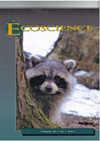Wiyâshâkimî湖(加拿大努纳维克)内陆帕尔萨泥炭地的全新世动力学
IF 1.3
4区 环境科学与生态学
Q3 ECOLOGY
引用次数: 2
摘要
摘要本研究考察了位于加拿大东北部努纳维克Wiyâshâkimî湖北岸的内陆亚北极永久冻土泥炭地的全新世演化。对植物宏化石的分析使我们能够重建沼泽和充满热岩溶的池塘的营养条件的序列。有机质的积累始于6290卡·年BP左右。然后,该遗址的演变经历了三个阶段:一个池塘(6290–5790 cal.y BP)、一个矿物营养泥炭地(5790–4350 cal.y BP)和一个非营养泥炭地。永久冻土的形成导致在170卡·年BP左右形成了沼泽,这相当于加拿大东北部小冰期最冷的时期。20世纪初开始的气候变暖导致了帕尔萨的退化和热岩溶池塘的形成。对邻近一个充满水的热岩溶池塘的植物宏化石的分析表明,在短短450年的时间里,植物的发育分为三个阶段:水下阶段、矿物营养阶段和复合营养阶段。结合之前对魁北克北部充满热岩溶的池塘的研究,这一结果表明池塘正在迅速被植被填满,并充当碳汇。本文章由计算机程序翻译,如有差异,请以英文原文为准。
Holocene Dynamics of an Inland Palsa Peatland at Wiyâshâkimî Lake (Nunavik, Canada)
ABSTRACT This study examines the Holocene evolution of an inland subarctic permafrost peatland located on the north bank of Wiyâshâkimî Lake (Nunavik, northeastern Canada). The analysis of plant macrofossils allowed us to reconstruct the succession of the trophic conditions of a palsa and a filled thermokarst pond. The accumulation of organic matter began at around 6290 cal. y BP. The evolution of the site then followed three stages: a pond (6290–5790 cal. y BP), a minerotrophic peatland (5790–4350 cal. y BP) and an ombrotrophic peatland (from 4350 cal. y BP). The establishment of permafrost caused a palsa to form at around 170 cal. y BP, which corresponds to the coldest period of the Little Ice Age in northeastern Canada. A subsequent degradation of the palsa and the formation of a thermokarst pond were induced by the climate warming that began at the turn of the 20th century. The analysis of plant macrofossils from an adjacent filled thermokarst pond indicated three phases of development over a short 450-year period: subaquatic, minerotrophic, and ombrotrophic phases. When combined with previous studies of filled thermokarst ponds in northern Québec, this result indicates that ponds are rapidly filling in with vegetation and acting as carbon sinks.
求助全文
通过发布文献求助,成功后即可免费获取论文全文。
去求助
来源期刊

Ecoscience
环境科学-生态学
CiteScore
2.80
自引率
0.00%
发文量
13
审稿时长
>36 weeks
期刊介绍:
Écoscience, is a multidisciplinary journal that covers all aspects of ecology. The journal welcomes submissions in English or French and publishes original work focusing on patterns and processes at various temporal and spatial scales across different levels of biological organization. Articles include original research, brief communications and reviews.
 求助内容:
求助内容: 应助结果提醒方式:
应助结果提醒方式:


